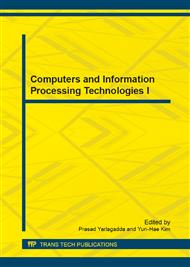[1]
A. Charnes, W. W. Cooper and E. Rhodes: Measurement the Efficiency of Decision Making Units. European Journal of Operational Research Vol. 2, Issue 6 (1978), pp.429-444.
DOI: 10.1016/0377-2217(78)90138-8
Google Scholar
[2]
B.P.S. Murthi, Yoon k. Choi and Preyas Desai: Efficiency of Mutual Funds and Portfolio Performance Measurement: A Non-Parametric Approach. European Journal of Operational Research, Vol. 98, Issue 2 (1997), pp.408-418.
DOI: 10.1016/s0377-2217(96)00356-6
Google Scholar
[3]
Chien-Jen Huang, P-W Chen and W-T Pan: Multi-stage Data Mining Technique to Build the Forecast Model for Taiwan Stocks. Neural Comput. & Applic., Online First TM (2011).
DOI: 10.1007/s00521-011-0628-0
Google Scholar
[4]
D.F. Specht A General Regression Neural Network, IEEE Trans. Neural Networks, Vol. 2, No. 6 (1991), pp.568-576.
DOI: 10.1109/72.97934
Google Scholar
[5]
J.H. Friedman: Multivariate adaptive regression splines. Annals of Statistics, Vol. 19, No. 1 (1991) pp.1-141.
Google Scholar
[6]
Jiah-Shing Chen, Jia-Li Hou, Shih-Min Wu and Ya-Wen Chang-Chien: Constructing investment strategy portfolios by combination genetic algorithms. Expert Systems with Applications, Vol. 36, Part 2 (2009), p.3824–3828.
DOI: 10.1016/j.eswa.2008.02.019
Google Scholar
[7]
J.J. Hopfield: Neural Networks and Physical Systems with Emergent Collective Computational Abilities. Proc. Natl. Acad. Sci. Vol. 79, No. 8 (1982), pp.2554-2558.
DOI: 10.1073/pnas.79.8.2554
Google Scholar
[8]
Jui-Fang Chang: Using investment satisfaction capability index based particle swarm optimization to construct a stock portfolio. Information Sciences, Vol. 181, No. 14 (2011), p.2989–2999.
DOI: 10.1016/j.ins.2010.05.008
Google Scholar
[9]
J. L. Treynor: How to Rate Management Investment Funds. Harvard 84 Business Review, Vol. 43 (1965), pp.63-75.
Google Scholar
[10]
Leorey Marquez and Tim Hill: Function Approximation Using Backpropagation and General Regression Neural Networks. In Proceeding of the Twenty-Sixth Hawaii International Conference on System Science, Vol. 4 (1993), pp.607-615.
DOI: 10.1109/hicss.1993.284240
Google Scholar
[11]
McMullen, Patrick R. and Robert A. Strong: Selection of Mutual Funds Using Data Envelopment Analysis. Journal of Business and Economic Studies, Vol. 4, Issue 1 (1998), pp.1-12.
Google Scholar
[12]
Meryem Duygun Fethi and Fotios Pasiouras: Assessing bank efficiency and performance with operational research and artificial intelligence techniques: A survey. European Journal of Operational Research, Vol. 204, issue 2 (2010), p.189–198.
DOI: 10.1016/j.ejor.2009.08.003
Google Scholar
[13]
M. J. Ferrell: The Measurement of Productive Efficiency. Journal of theRoyal Statistical Society, Vol. 120, Part 3 (1957), pp.253-281.
Google Scholar
[14]
Peng-Wen Chen, Wei-Yuan Lin, Tsui-Hua Huang and Wen-Tsao Pan: Using Fruit Fly Optimization Algorithm Optimized Grey Model Neural Network to Perform Satisfaction Analysis for E-Business Service. Applied Mathematics & Information Sciences, Vol. 7, No. 2L (2013).
DOI: 10.12785/amis/072l12
Google Scholar
[15]
Razieh Bahrani and Nader Khedri: Evaluation of Relative Efficiency and Performance of Companies Using Data Envelopment Analysis (DEA) Approach. Elixir International Journal, Elixir Fin. Mgmt. 56 (2013) , pp.13299-13304.
Google Scholar
[16]
Ruay-Shiung Chang, Jih-Sheng Chang and Po-Sheng Lin: An ant algorithm for balanced job scheduling in grids. Future Generation Computer Systems, Vol. 25, Issue 1 (2009), p.20–27.
DOI: 10.1016/j.future.2008.06.004
Google Scholar
[17]
Wen-Tsao Pan: A New Fruit Fly Optimization Algorithm: Taking the Financial Distress Model as An Example. Knowledge-Based Systems, Vol. 26 (2012), pp.69-74.
DOI: 10.1016/j.knosys.2011.07.001
Google Scholar
[18]
Wen-Tsao Pan: Performing stock price prediction use of hybrid model. Chinese management studies : CMS. -Bingley : Emerald, Vol. 4, Issue 1 (2010), pp.77-86.
DOI: 10.1108/17506141011033016
Google Scholar
[19]
W. F. Sharpe: Mutual Fund Performance. Journal of Business, vol. 39, No. 1, Part 2 (1966), pp.119-138.
Google Scholar


